Ultimate Guide to Eating the Mediterranean Diet
By Bill Bradley, R.D.
Updated March 14, 2025
What is the Mediterranean Diet?
The Mediterranean Diet has been in the news a lot in the past few years. It has been voted the #1 diet by U.S. News & World Report. Not only was it voted the top overall diet, it was also rated the best healthy eating diet, the easiest diet to follow, the best diet for diabetes, the best heart-healthy diet, and the best plant-based diet.
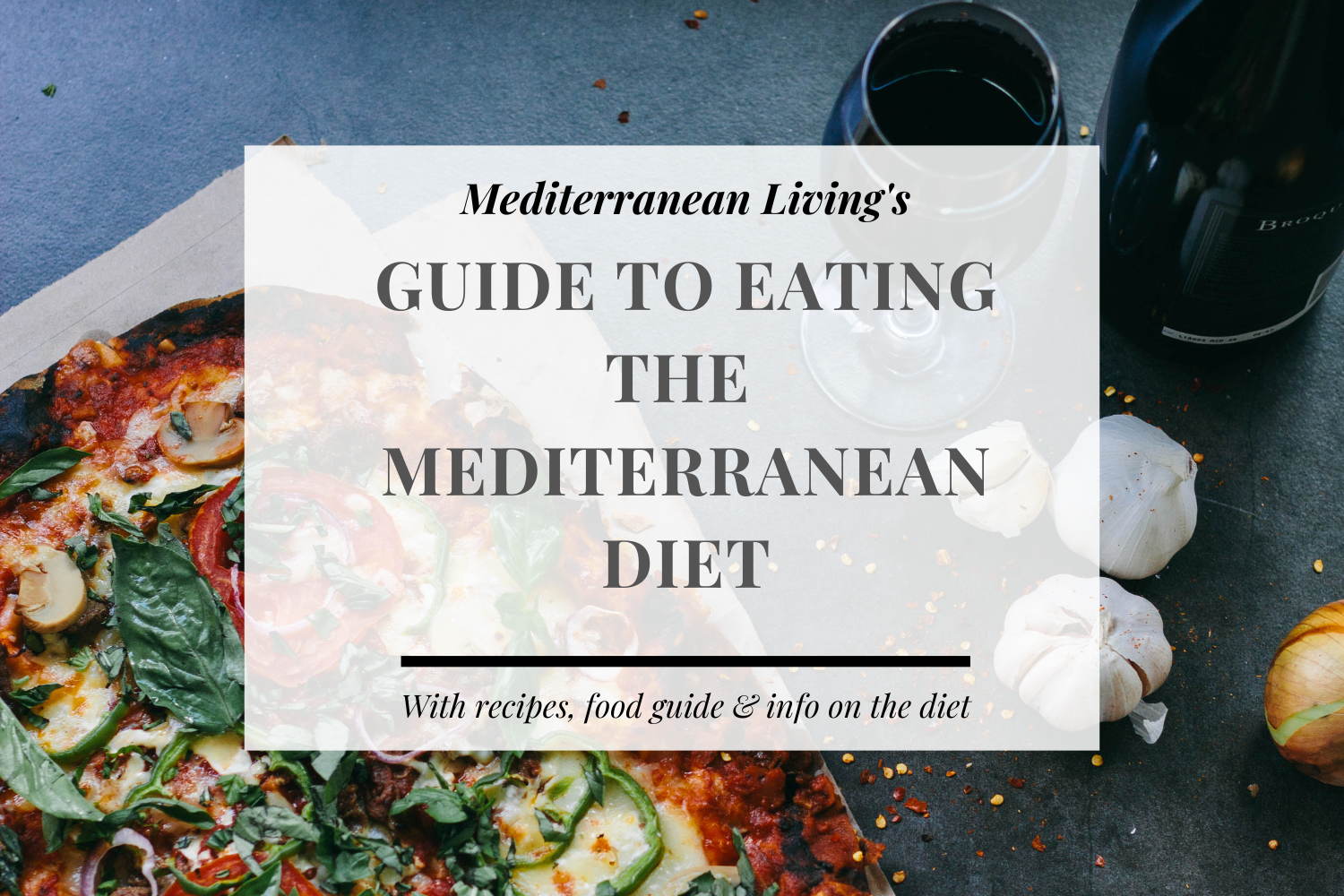
I would also add that, in my humble opinion, it is the best tasting diet out there. But what is the Mediterranean Diet?
I always have a good laugh when I hear someone say that the Mediterranean Diet is a fad since it is one of the oldest diets in the world. It has been around since the beginning of recorded history. Jesus and Muhammad ate the Mediterranean Diet. Michelangelo, Cleopatra, Pablo Picasso, Leonardo Da Vinci, Julia Child and Napoleon all ate Mediterranean.
Check Out Our Video – Easy Guide for Beginners – to Get Started
Health Benefits of Eating the Mediterranean Diet
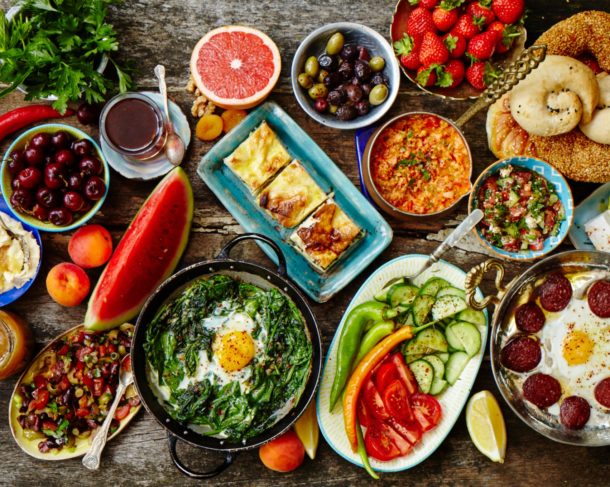
Turkish Meal from Ozlem’s Turkish Table Cookbook
There are thousands of studies on the Mediterranean diet showing benefits for everything from arthritis to dementia, alzheimer’s, heart disease, cancer and longevity. Doctors and dietitians are telling their patients to eat the Mediterranean Diet, but there seems to be some misconceptions and lack of education about what the diet really is.
Click Here to Download the Guide to Eating Mediterranean as a PDF!
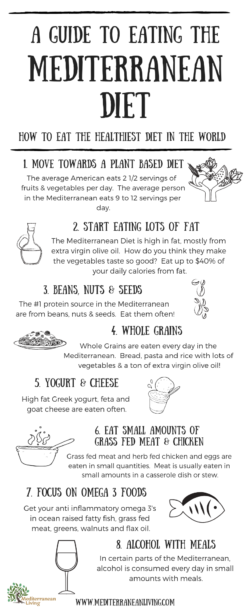
What is the Mediterranean Diet?
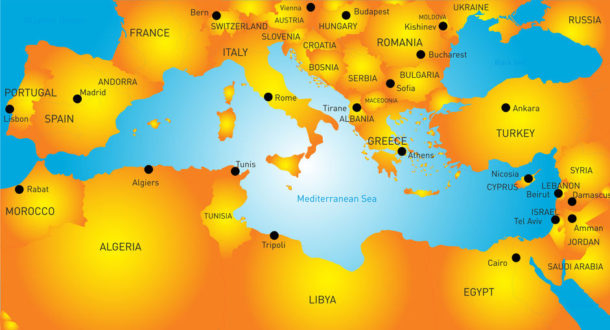
The Mediterranean Diet is the food and recipes eaten by those who live in the countries surrounding the Mediterranean Sea. This includes gastronomic delights from Southern Europe (Greece, Spain, Italy, France, Albania, Monaco, Croatia, Bosnia and Malta), the Middle East (Syria, Israel, Cyprus, Lebanon, and Palestine), and Northern Africa (Egypt, Libya, Morocco, Tunisia and Algeria).
The heart of the Mediterranean Diet (where the healthiest people live) is often considered to be Spain, Italy and Greece and the islands of the Mediterranean (including Crete, Sardinia and Ikaria). Even though the recipes vary widely from country to country, the base ingredients are the same.
The Ingredients of the Mediterranean Diet
Fresh Extra Virgin Olive Oil
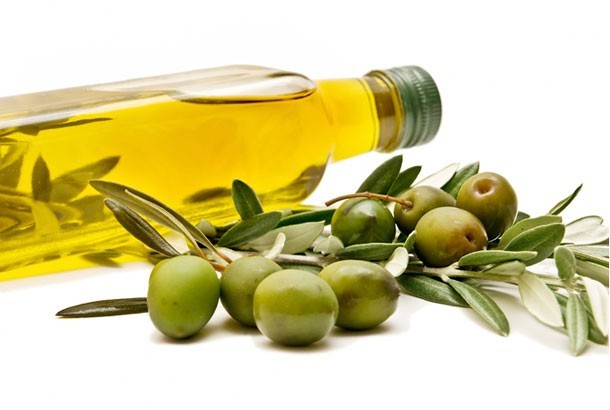
There is a saying on the Greek island of Crete, home of some of the healthiest people in the world, “We have olive oil in our veins.” This isn’t at all an exaggeration. The traditional Mediterranean Diet is a high fat diet (and yet they have the lowest heart disease rates in the world). Up to 40% of daily calories come from fat, 30% of daily calories is from extra virgin olive oil.
As you may have heard, 75% of the olive oil sold in the United States is fraudulent in one way or another. Using the highest quality, freshest extra virgin olive oil is super important for your health for the following two reasons:
-
- Extra virgin olive oil comes from the first pressing of the olives. This means that the oil is still full of sediment. It is unfiltered, thick and colorful. The sediment is full of antioxidants, which are lost to a great extent once the oil is filtered.
- A really fresh extra virgin olive oil will cause a peppery burn in the throat about 10 seconds after being swallowed. This component of the oil that causes the burn mimics the chemical that is in ibuprofen. It is a very strong anti-inflammatory with only healthy side effects that was used in ancient Greece to cure headaches and toothaches.
Bitter Greens
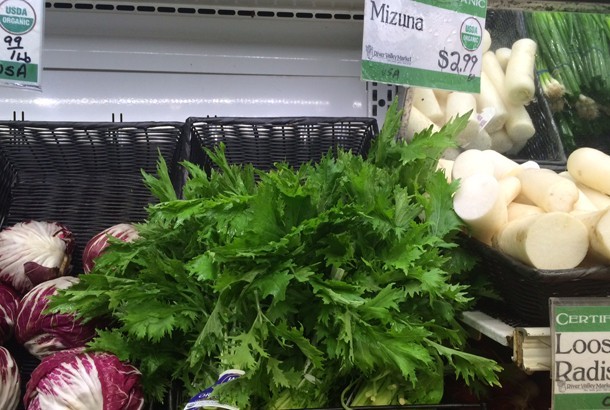
If you look at the diets of the healthiest people around the world, one of the common denominators are bitter greens. Bitter greens are like a natural vitamin supplement full of vitamins and minerals including Vitamins A, C, and K. Some greens are loaded with healthy Omega-3 fats.
The bitter flavor stimulates digestion and helps to detoxify the body. One word of caution: If you add sweetness (such as honey) to reduce the bitterness, you also reduce the digestive benefit, which actually starts with the bitter flavor receptors on the tongue. If you think you don’t like bitter greens I recommend trying a Cretan recipe such as Horta with Potatoes and I think you will change your mind.
Organic Vegetables and Fruits
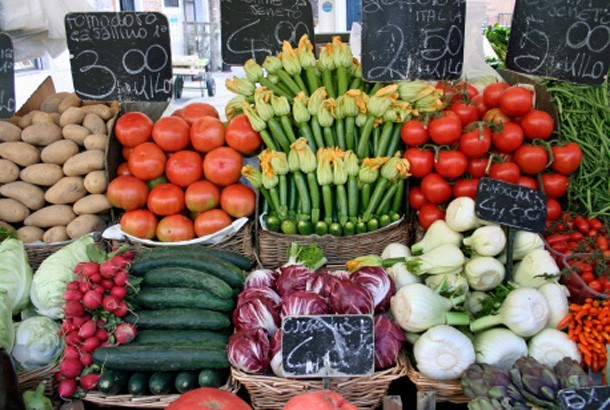
The average American eats 2 1/2 servings of fruits and vegetables a day. The average Cretan eats 9 to 12 servings a day! Most meals are vegetable based meals.
Stews may contain a small amount of meat along with plenty of veggies and olive oil. This will usually be accompanied by a salad and possibly a few vegetable side dishes.
As with the bitter greens, if you don’t think you like vegetables I would highly recommend trying some of the traditional Mediterranean recipes on our site. The nutritional value of fruits and veggies are always best from local, organic farms and picked at maximum ripeness.
Beans, nuts, and seeds
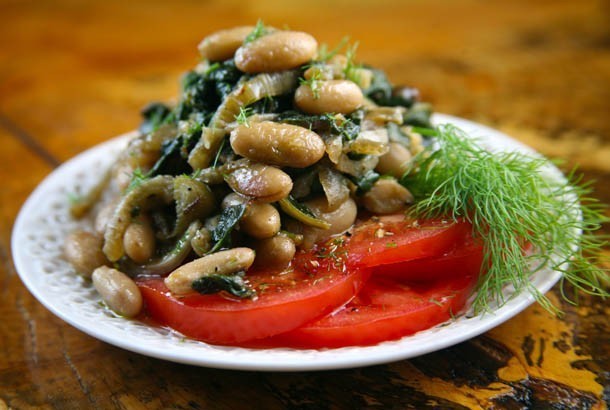
The main protein eaten in the U.S. is meat, while the main sources of protein in the Mediterranean are beans, nuts, and seeds. Beans, nuts, and seeds are eaten almost every day.
Grass Fed/Free Roaming Meat, Poultry, Eggs, and Dairy
Everywhere you look in rural Mediterranean areas, you will see animals roaming the countryside, eating herbs and berries from trees. Grass fed animals are leaner and healthier, and because they are eating herbs instead of grains their meat has high levels of omega-3 fats. These essential fats, which are deficient in the diets of most Americans, help with everything from bone health to depression.
Wine and Moonshine

I am a bit of lightweight when it comes to drinking. When I am on the Greek island of Crete and drinking the average amount of wine and moonshine I feel as if I am in a constant, mellow state of buzz. Everyone drinks wine on a daily basis on the island (yes, even kids). It is customary to have a glass or two of homemade wine at lunch and at dinner.
Some even have a glass at breakfast! To top it all off, a moonshine called raki (made from distilling the seeds and skins of grapes after making wine) is often served at the end of the meal. A small amount of alcohol with your meal has been shown to have beneficial effects on your heart and can increase your HDL (“H” for healthy) cholesterol. Of course, if you don’t drink alcohol or have an issue with it, I don’t recommend starting. You can also increase your HDL with exercise.
Fish and Seafood from the Sea or Ocean

Most people overestimate how much fish is eaten in the Mediterranean. The average person in Crete eats about 6 ounces of fatty fish per week. That is about the size of a small can of tuna.
Fatty fish from the ocean is packed with healthy omega-3 fats. Sardines and other fish that are eaten whole are an incredible source of calcium. Fish and seafood in Crete are often cooked in soup with lots of veggies and olive oil.
Whole Grains
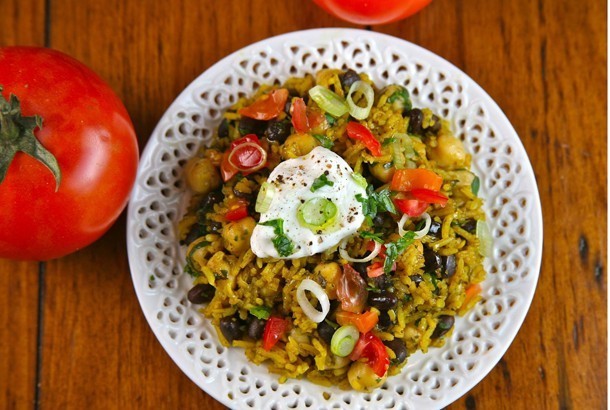
If you travel to the healthiest places in the world with the highest longevity rates you will always find a plentiful amount of grains in the diet. In much of the Mediterranean, bread often made with a sourdough starter, as opposed to yeast.
Sourdough bread has a lower glycemic index than yeast bread and some think it might be slightly healthier for you. It is eaten at almost every meal, but not in huge quantities, and always in conjunction with lots of veggies, olive oil, beans, or meat.
The same is true for rice and pasta. You aren’t going to get a huge bowl of pasta with meatballs, buttery garlic bread, and a tiny salad like you do if you go to an Italian restaurant in America. Instead, you will get a large salad, some bread, a casserole with more veggies, and side dishes including grains, vegetables, and some meat or beans.
Fresh Mountain Herbs/Teas

The last time my wife Christine and I were in Crete we visited my co-author Koula Barydakis. She brought us high into the mountains to a traditional Cretan restaurant. When we sat down, the owner came out and asked us if we would like some tea.
Instead of heading into the kitchen, he went out the front door, and we followed him as he picked fresh leaves from the herb bushes in his garden. These herbs included mint, wild marjoram, thyme, and some I hadn’t heard of. He brought them into the kitchen, steeped them in hot water and served it to us as a delicious, healing tea.
The tradition of herbal teas for health has remained strong on the island and continues to be an important part of everyday life.
Fresh Herbs and Spices
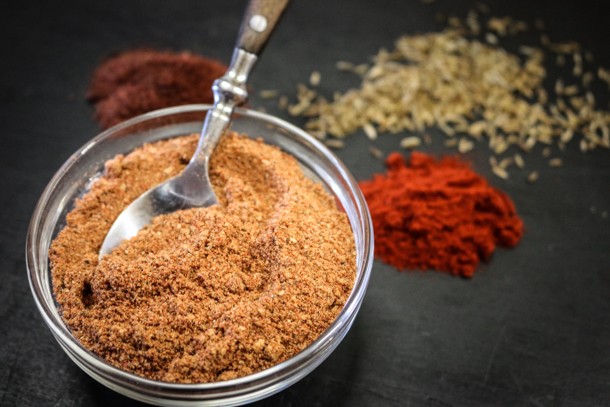
The benefits of herbs and spices for health has been known in the Mediterranean for thousands of years. Many herbs, such as oregano are used to help digestion, especially after eating a heavy meal. From the anti-inflammatory turmeric, cinnamon and ginger used in Moroccan cooking to the immune boosting qualities of oregano and basil, herbs and spices are used often and deliberately to increase flavor and improve health.
Creating a Mediterranean Kitchen
I used to work 1:1 with clients in their homes helping them to eat the Mediterranean Diet. The first step was always to transform their kitchen from an American, highly processed kitchen to a Mediterranean kitchen. I think this act alone can have huge benefits on your health.
We would take out all the processed, sugary foods as well as go through the spices and throw out all the old, flavorless ones especially spices from the 1970’s (this really happened).
Creating a Mediterranean based kitchen makes it easy to eat well without the risk of filling up on candy, chips and cookies. We have put together a Mediterranean Diet food list for you so you will have an idea of which foods to purchase to create a true Mediterranean Kitchen.
Mediterranean Diet Food List Printable PDF
This Mediterranean diet food list is available as a PDF file, and I recommend printing it out and putting it on your fridge. You will always have inspiration to eat these healthy foods whenever you go into the fridge.
If you’re looking for recipes to make with these foods, check out our extensive collection of Mediterranean Diet Recipes.
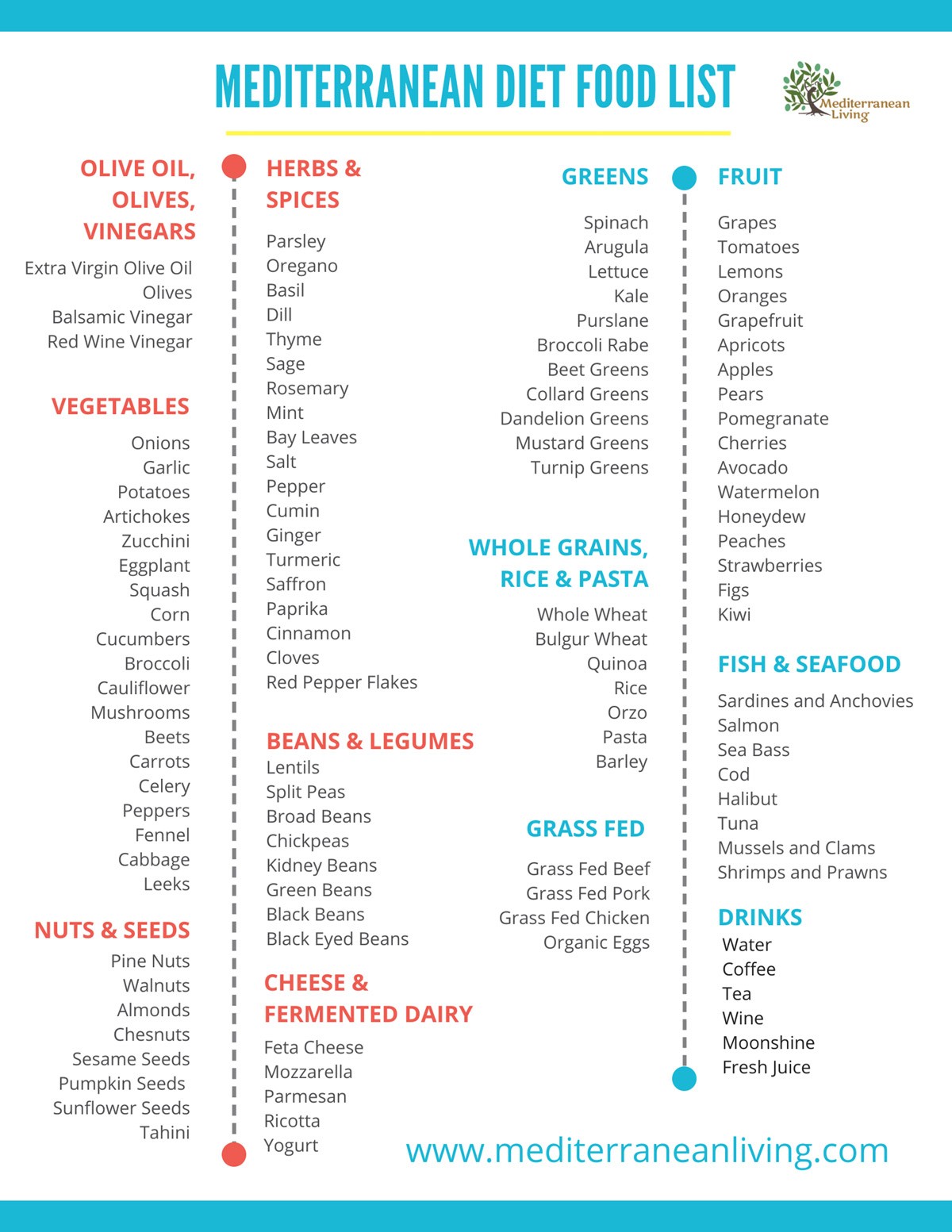
Some of our favorite recipes:
If you want to really eat the Mediterranean Diet, the best way is to try some recipes. Here we give you some of our favorite beginning recipes that are easy to make. We also included some of our Instant Pot recipes if you are looking for super quick!
1. Loaded Tzatziki Yogurt Sauce with Fresh Dill, Garlic, and Cucumber
Last time we were in Crete, my wife made me promise to stop ordering so much Tzatziki. It seriously became a problem, but that’s how much I love it (she loves it too!). The creamy Greek yogurt (the highest fat possible), grated cucumbers, chopped fresh dill, garlic and olive oil create an irresistible and very healthy sauce that is great on fritters, bread, vegetables, burgers, and souvlaki just to name a few. Every chef has their own version of tzatziki, some are mild and some are potent with garlic and dill. This is the loaded version, loaded with flavor that is!
Recipe Here!
2. Authentic Greek Salad (Horiatiki Salata)
In 2014, I visited Greece for the first time. I had waited my entire life to eat real Greek food seeing that I’m half Greek. I was also hoping to collect some authentic Mediterranean Diet recipes.
I arrived in Athens and was set to go on a study tour throughout the country. I got to my hotel and the study group was waiting for me to go to dinner together. I put my luggage in my room and we walked through the busy streets to a traditional Greek taverna. The waiter brought us bread with extra virgin olive oil to dip.
The oil was so good. Then he brought the greek salad. This was a moment I will never forget. I took one bite of a red, juicy tomato slice and I thought to myself “What have I been eating my whole life?!” This was the sweetest, most flavorful, deep red, and beefy tomato I had ever sunk my teeth into.
Recipe Here!
3. Spinach with Feta and Lemon
If you are looking for a super quick Mediterranean Diet side dish recipe that will satisfy everyone then you have come to the right place! Spinach with feta and lemon takes about 10 minutes to make, is ridiculously delicious and will go with just about any main dish whether it’s chicken, fish, meat or beans. Serve this with warm, crusty bread for sopping up the olive oil and pot liquor.
Recipe Here!
4. Horta and Potatoes
Horta and potatoes are a Mediterranean diet recipe eaten every day in Crete. In the springtime, it’s a normal sight to see the older ladies of the village foraging on the side of the road for wild edible greens.
All year long there are a wide variety of edible greens available at the farmer’s markets. Potatoes are a staple in the Cretan diet. The flavor of both Horta and potatoes are enhanced with fresh lemon juice. Citrus trees grow everywhere in Crete so it’s as simple as walking to the nearest lemon tree and picking them.
Combine these greens, potatoes, and lemon with lots of fresh extra virgin olive oil and you have one of the healthiest, inexpensive, and fulfilling dishes from Crete.
Recipe Here!
5. Chicken Leek Soup with White Wine (Island of Crete)
We had this chicken leek soup again last night and my wife asked me “why is this soup so good?”. It’s a question worth exploring because it is the favorite soup in my cooking classes as well. It is so simple and just a scan of the ingredients wouldn’t have me running to make it.
But, the blend of chicken sautéed in olive oil, wine, and leeks makes for a delicious combo that is well worth the minimal effort of making it. It is a healing soup and a few weeks ago I made it when Christine and I both had colds. It also works as an opener to a fancy dinner party because of it’s simplicity combined with its rich, flavorful broth.
Recipe Here!
6. Shrimp with Feta and Tomatoes
My first stop at most parties is the appetizer table. Ninety percent of the time, the same dishes appear and most of them are not part of the Mediterranean Diet: crackers with 3 different types of cheese; chips with dip; a vegetable platter; kielbasa with mustard; deviled eggs; and of course shrimp cocktail.
I used to love shrimp with tangy cocktail sauce, but I have had so much of it over the years that it’s lost it’s appeal. Luckily for us, Koula Barydakis has given us a traditional Greek shrimp recipe that made me love shrimp again! This recipe works as both an appetizer or as the main dish.
When I have it for dinner I pair it with greens (horta) and potatoes and white wine. I think you will find this to be an amazing new way to cook shrimp that will add new flavor to both your parties and dinners.
Recipe Here!
7. Traditional “Greek Restaurant” Salad Dressing
A Greek salad in an American Greek restaurant is quite different than a Greek salad eaten in Greece. Here, in America, a Greek salad is made up mostly of iceberg lettuce and then some tomatoes, peppers, cucumbers, black olives, and feta cheese.
It is all topped off with a huge squirt of a “Greek” Mediterranean salad dressing. Even though I much prefer the Greek salad of Greece, which has no lettuce and more of all the good stuff including a dressing made up of just lemon juice and extra virgin olive oil, I still like the American version every once in a while.
The American “Greek” dressing is always very flavorful and for many years I have tried to perfect my own version. I think I have finally done it! This dressing will last at least a week and a half in the fridge and is delicious whether you make your Greek salad with or without lettuce. It also makes a great marinade for chicken or fish. Enjoy!
Recipe Here!
8. Italian Farmhouse Tomato Sauce
This easy Mediterranean Diet recipe for Italian Farmhouse Chunky Tomato Sauce is so full of flavor it almost doesn’t need pasta (but I highly recommend some)! And because I use a lot of sauce and a small amount of pasta when I eat it, it is low in calories yet filling and immensely satisfying. Mushrooms, spinach, tomatoes, parsley and garlic means this sauce is packed with anti-inflammatory polyphenols, antioxidants, and vitamins.
Recipe Here!
9. Greek Lemon and Garlic Potatoes
Are you passionate about potatoes and think you can’t eat them on a Mediterranean diet? Think again! Try one the most popular recipes from our Foods of Crete cookbook. This recipe uses a long cooking method, which results in potatoes with a crispy exterior and soft interior. The prep is fast and easy so you give just a little effort for great results! We’re sure these garlicky lemon potatoes will become a side dish favorite in your home.
Recipe Here!
10. Chicken Souvlaki with Grilled French Bread and Tzatziki
One of my favorite Mediterranean Diet recipes is eating souvlaki from a street vendor in Greece. They start with well marinated chicken on a stick cooked slowly over a wood fired grill. As the chicken cooks, they sprinkle salt and squeeze lemon juice on the tasty morsels.
Usually, it is served with a slice of bread that has been drizzled with olive oil and grilled. Our recipe for chicken souvlaki takes the traditional recipe, but adds Greece’s famous yogurt Tzatziki Sauce to create the perfect summer dish alongside a Greek salad or a fried potato, tomato and arugula salad and a bottle of red or white wine.
Serve this at a summer barbecue and your guests will become your biggest fans. Did we mention that it is remarkably quick and easy? Souvlaki is a no fuss option that quickly comes together with just a few ingredients. As a plus, there is very little kitchen cleanup!
Recipe Here!
11. Sauteed Mushrooms with Garlic and Thyme
Mezes and tapas are one of the reasons I love eating the Mediterranean Diet. I always order some version of Sautéed Mushrooms with Garlic and Thyme whenever I make it to a tapas restaurant. It is a dish that goes with almost any other type of food from beans to chicken to fish.
Of course, this recipe has lots of olive oil so you can sop up the flavorful juices with bread. This dish goes very nicely with Baked Cod with Sun-Dried Tomatoes and Olives or Chicken Souvlaki with Grilled French Bread and Tzatziki. Enjoy!
Recipe Here!
12. Black Eyed Peas with Fresh Dill, Olive Oil and Orange Slices
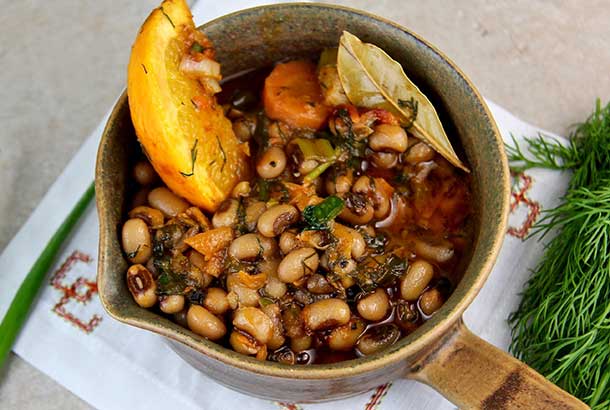
Black eyed peas with Fresh Dill, Olive Oil and Orange Slices is one of my all-time favorite Mediterranean Diet recipes. How can you go wrong with fresh dill, fresh parsley, green onions, orange slices, and 1 cup of extra virgin olive oil.
As you prepare this amazing dish, I would highly recommend resisting the urge to cut back on the olive oil. As you simmer the ingredients, the oil cooks into the beans and herbs and what is left thickens to make a flavorful gravy.
This is a traditional vegan dish from the island of Crete and works great with a vegan salad. If you are not vegan, you can eat it with our authentic Greek salad for a meal that is comforting, filling and good for you!
Recipe Here!
13. Grilled Marinated Summer Vegetables
This is one of the first recipes I learned as a kid. Whenever my family grills, we like to grill lots of vegetables alongside the meat or fish we’re having. Grilling the vegetables brings out the sweetness. You can use whatever vegetables you have for this recipe, and I change it up sometimes.
My favorite combo though is different colored bell peppers, zucchini, summer squash, mushrooms, and tomatoes. This is a good variety because some people may not like one or two of the vegetables, but you can almost guarantee they like at least one of them.
Recipe Here!
14. Ziti with Roasted Cherry Tomatoes and Eggplant
I love to cook, but I don’t always love to cook. Sometimes, I want something yummy with the least amount of work possible. This Ziti with Roasted Cherry Tomatoes and Eggplant is one of those recipes that tastes like you’ve worked on it more than you actually have. It is a super simple recipe! Preheat the oven, slice the eggplant, onion and garlic and roast it along with cherry tomatoes for an hour. Add to pasta and you are done. Simplicity at it’s best.
Recipe Here!
15. Tuscan White Bean Soup with Sausage and Kale
This Tuscan White Bean Soup with Sausage and Kale will make you feel like you are eating in a small restaurant in Italy. It is the perfect hearty soup for a wintry day. Most beans soups are full of nutrition and this one is no exception: fiber from the beans and kale; vitamins A, K and C from the Kale; protein from the beans and sausage and healthy fat from the extra virgin olive oil.
Although, I don’t eat sausage often, I still try to get uncured sausage from grass fed animals. This makes for a much healthier sausage. This is a great recipe for someone who is being introduced to the Mediterranean Diet as it still has a meaty taste to it, but is also packed with lots of healthy vegetables, beans and herbs.
Recipe Here!
Instant Pot Recipes
We have realized that many of the one-pot Mediterranean recipes we’ve been eating for a long time work perfectly to make healthy instant pot recipes that are easy and quick. Once you learn how to use the Instant Pot correctly, you can have a healthy Mediterranean meal on the table in no time.
The meat comes out tender and the vegetables cooked all the way through. The Instant Pot also does a great job of creating sauces and broths that are perfect for mopping up with good crusty bread. If you don’t have an Instant Pot yet, what are you waiting for? It will change the way you cook and will save you so much precious time. Enjoy these recipes and share them with your friends and family!
Instant Pot Fasolakia (Green Beans and Potatoes in Olive Oil)
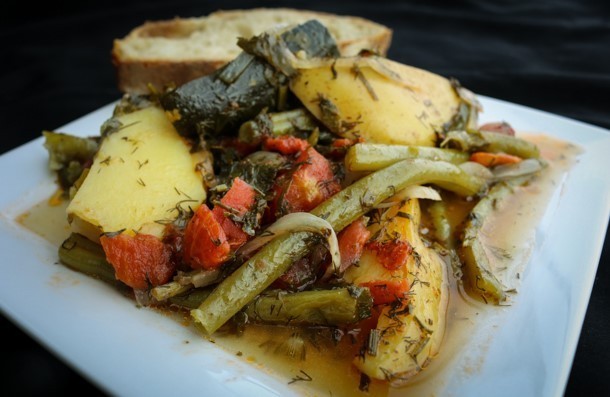
Beans are huge in the Mediterranean Diet. Fasolakia is a very traditional Greek dish in the “ladera” family. “Ladera” are foods cooked in a lot of olive oil that are served warm or at room temperature. They are usually cheap to make but very filling and delicious. This is one of the best instant pot recipes i’ve tried.
Recipe Here!
Instant Pot Horta and Potatoes
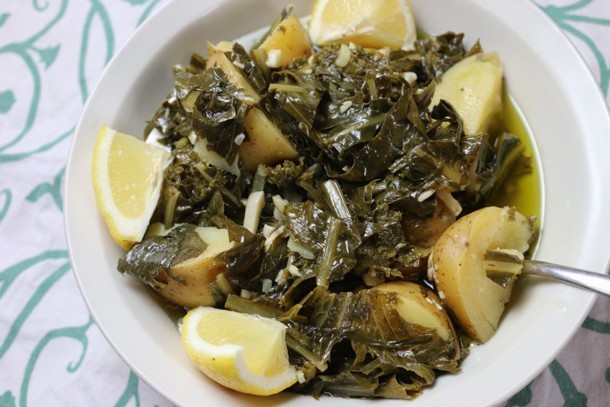
This horta recipe has been one of our most popular recipes on Mediterranean Living for a long time and now the Instant Pot version is here! The normal version takes around an hour to cook. Horta (Greens) and potatoes in the instant pot takes only 15 minutes! The end result is amazingly the same.
Recipe Here!
Instant Pot Moroccan Chicken Tagine with Green Olives, Peppers, and Lemon
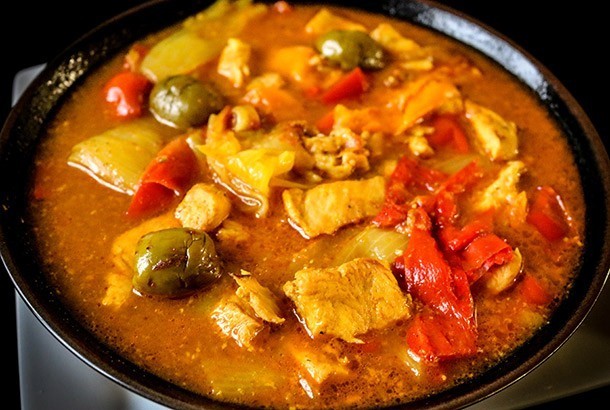
This Moroccan inspired dish is a fusion between a Mediterranean Diet recipe and the flavors of New England. I have cooked this for thousands of people in my workshops and many have told me that I should bottle the sauce. It is the perfect blend of sweet and tangy, combining honey, molasses and Dijon mustard with Moroccan spices.
You can cook this on the stove top, a Dutch oven or in a crock pot, but here we use an instant pot which cuts the cooking time in half and the instant pot chicken comes out even more tender than other cooking methods.
Recipe Here!
Instant Pot Beef Stew with Sage and Red wine (Italy)
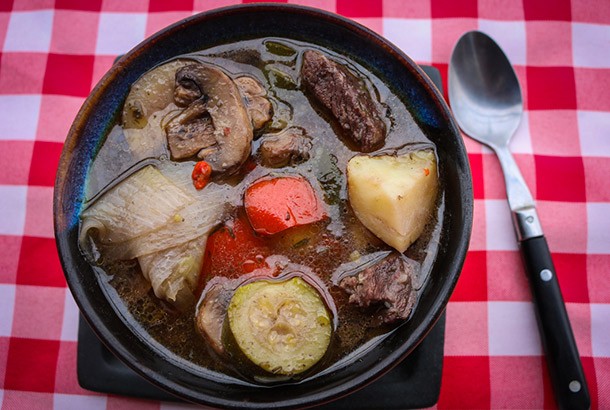
This Instant Pot beef stew is an adaption of an old traditional Italian recipe. The rich blend of beef, sage and red wine makes me think of a family eating in a rustic farmhouse. Like any good beef stew it is best served with bread to sop up the delicious juice. You can also serve with rice or egg noodles. I personally often eat this stew without any grain at all.
Recipe Here!
Instant Pot Chicken with Lemony Mustard Greens and Olives
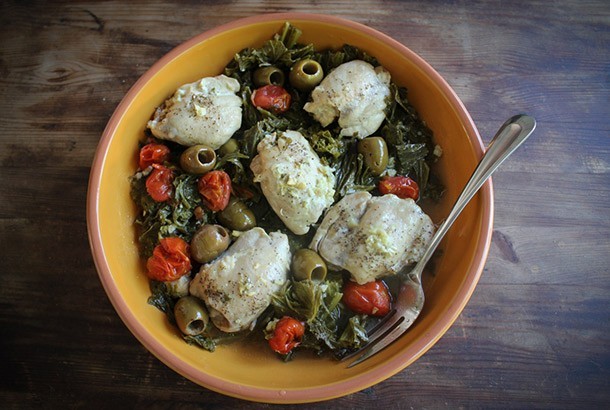
The newest of my Instant Pot Chicken recipes! A few months ago I created a recipe using chicken thighs, mustard greens, and olives in the cast iron skillet. I thought this would be a perfect recipe to adapt for the Instant Pot. The reason I created the first recipe was because I wanted a recipe that would have people enjoying mustard greens.
Recipe Here!
Instant Pot Green Beans with Pork and Potatoes
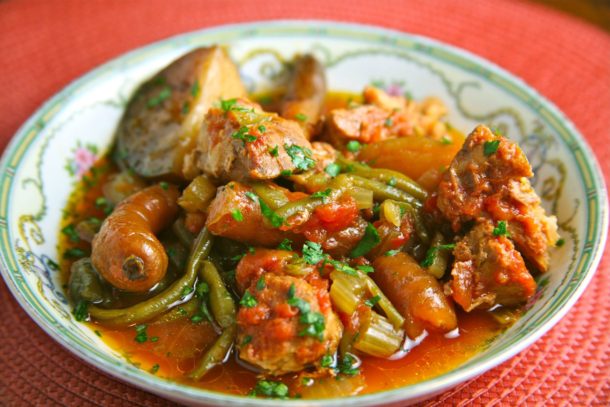
This is a slow-cooker Mediterranean diet recipe adapted for the Instant Pot. The original version of Instant Pot Green Beans and Pork took at least 6 hours in the slow-cooker, but now you can make this recipe in 30 minutes or less! This is the perfect meal to make when you get home from work because your family will think you spent hours cooking. The pork cooks down to be fork tender. The potatoes, green beans, carrots, and celery cook all the way through but don’t get mushy. It tastes like it’s been cooking all day long.
Recipe Here!
Instant Pot Black Eyed Peas with Fresh Dill and Parsley
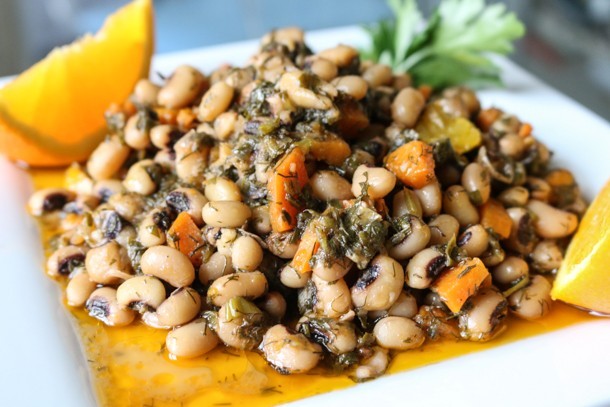
This recipe, by Koula Barydakis, has been on Mediterranean Living since 2013. It’s an absolute go-to recipe for us. Five years have gone by and we got our hands on an Instant Pot Cooker. Now this traditional recipe from Crete, that was already super simple to make, is even simpler!

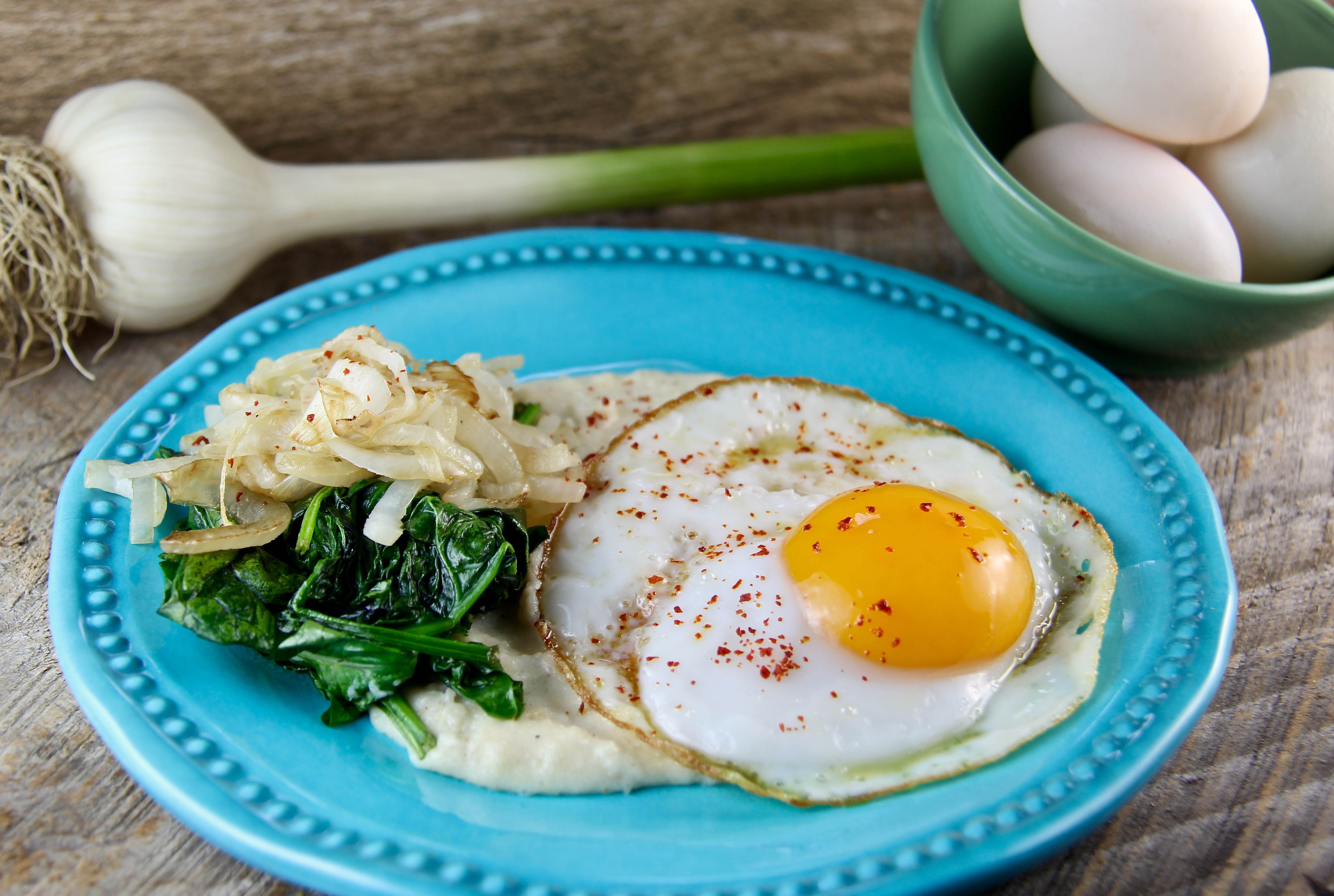
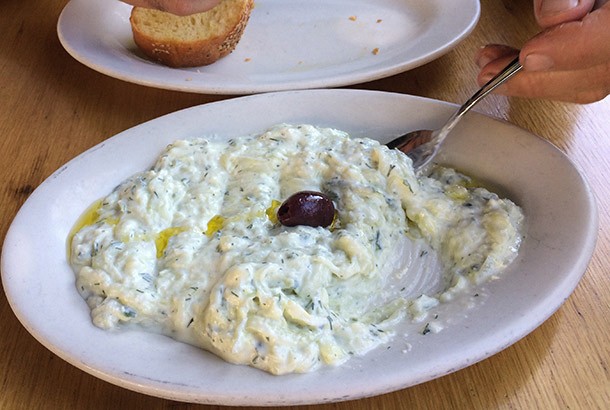
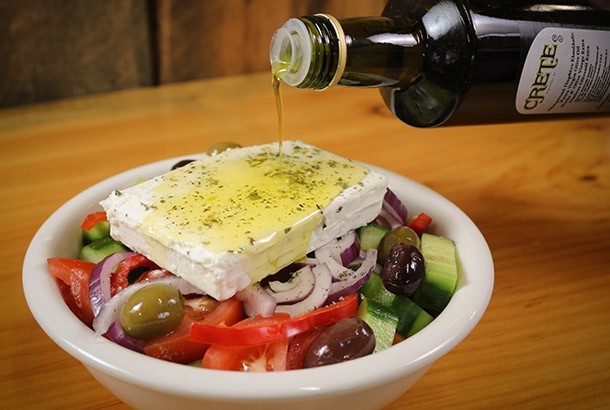

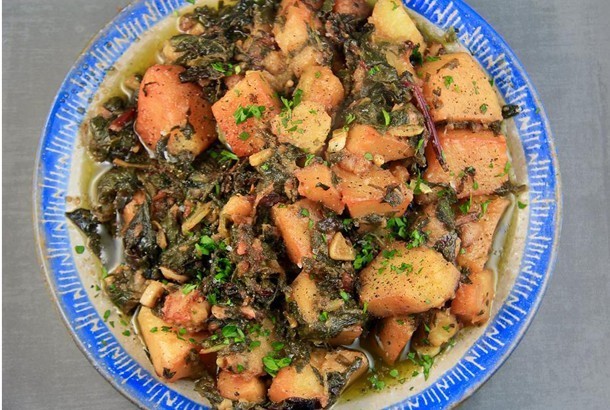
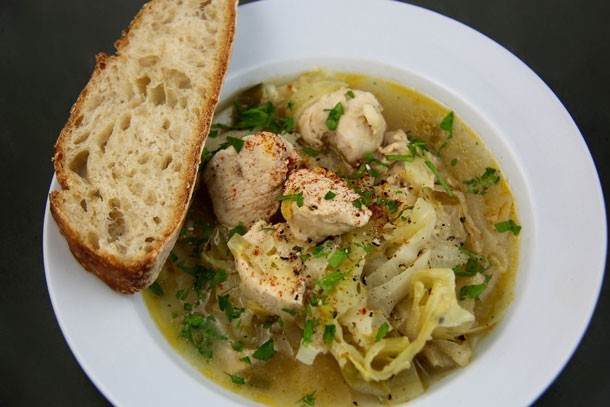
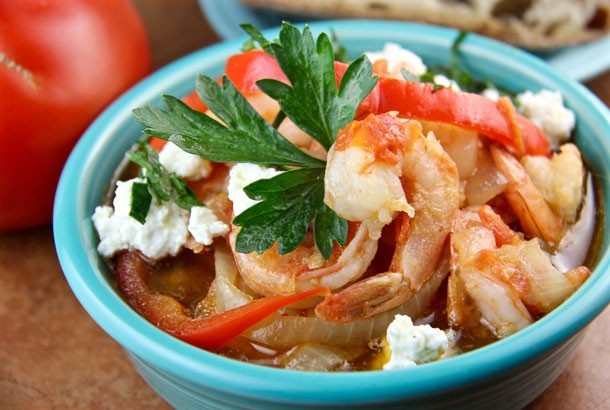
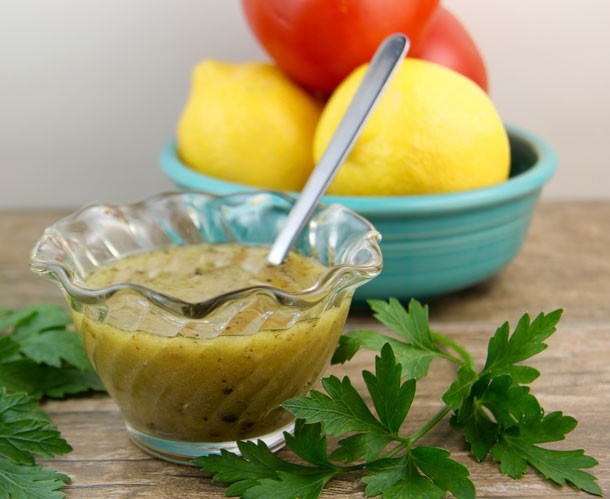
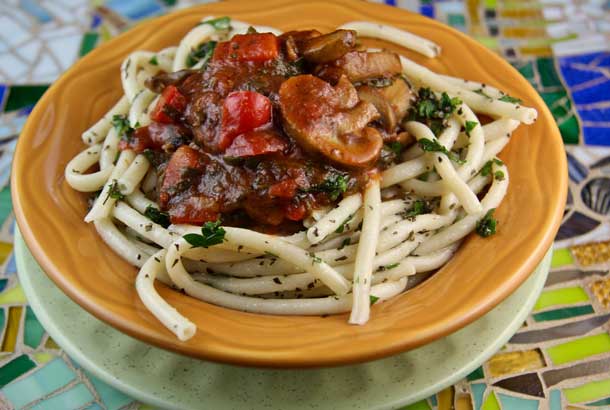
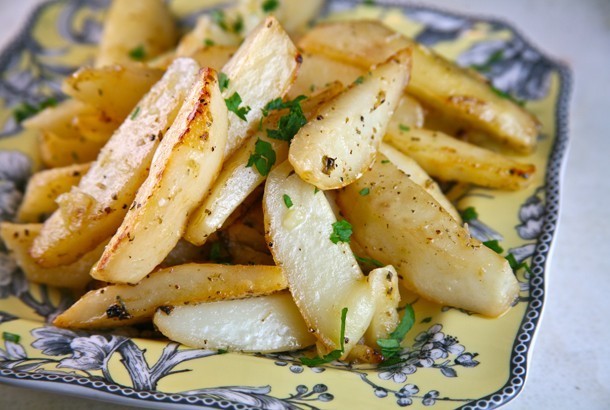
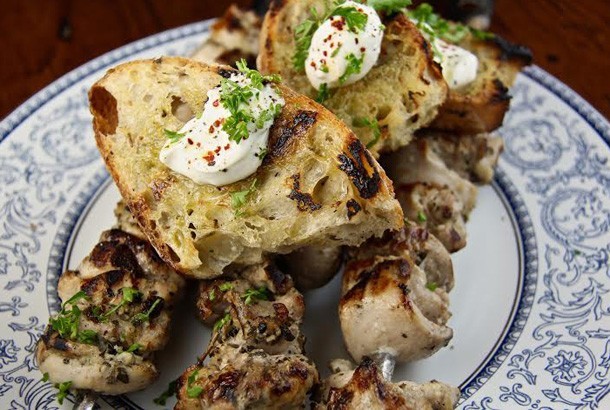
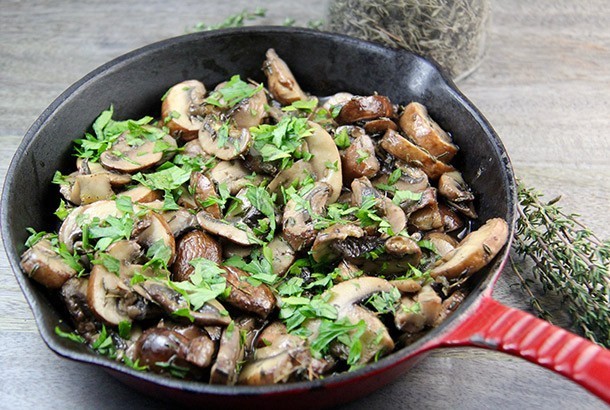
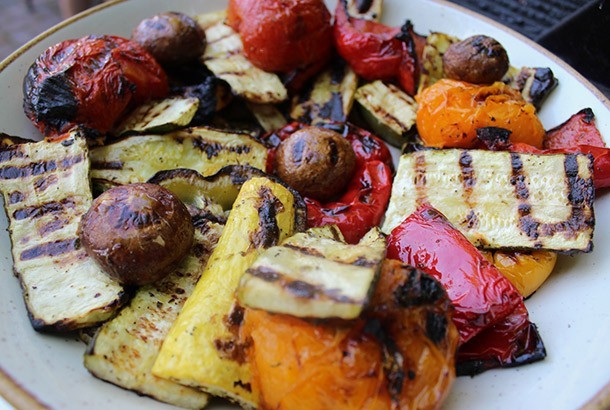
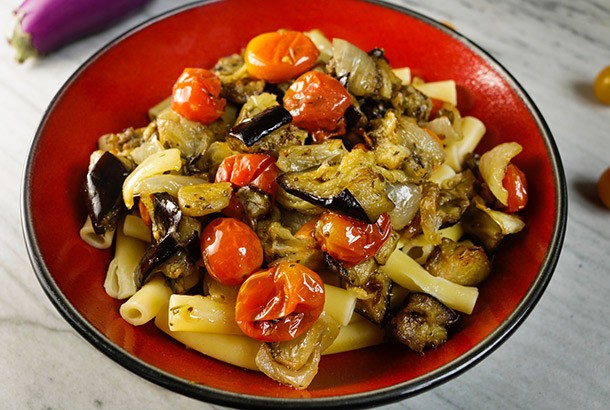
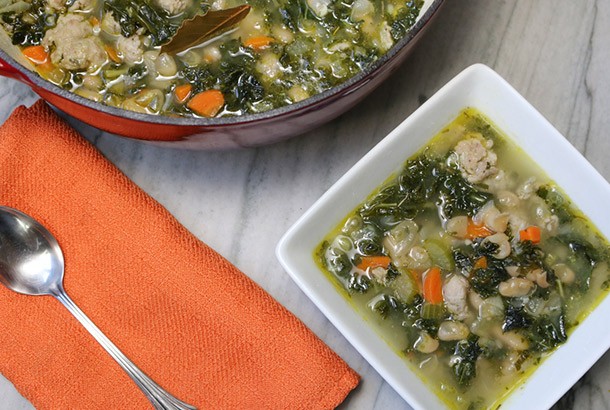







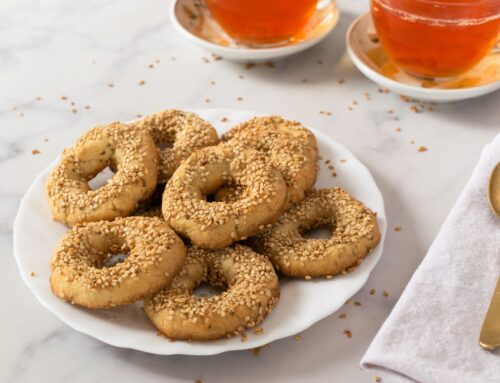
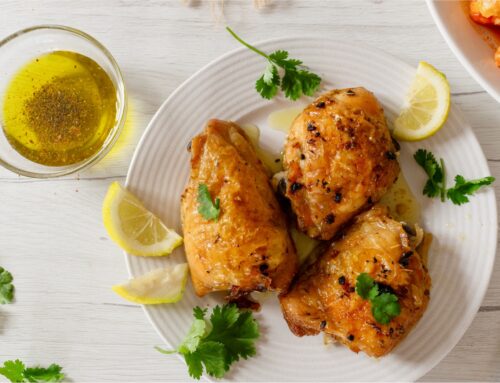
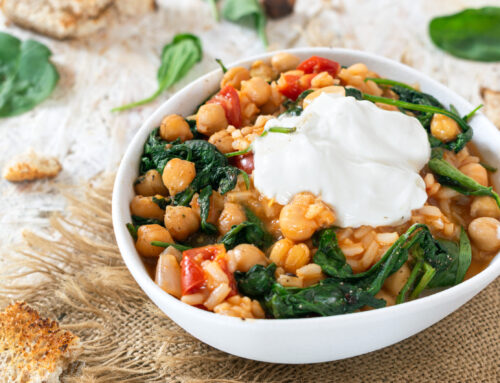
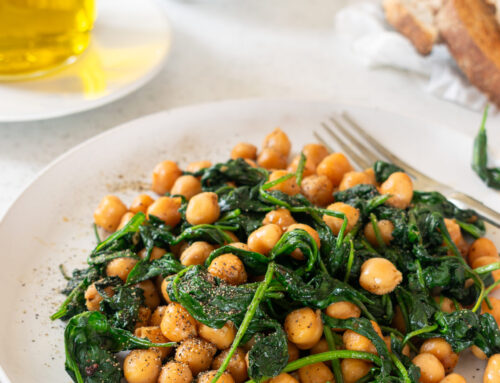
I used to live in Crete and Greece and Bahrain (from where I used to fly to all the southern Mediterranean countries.) I have found that the reason so many people feel the Mediterranean Diet is a fad is that there is an actual ‘Mediterranean Diet’ running around the internet that is a pale imitation of the real thing. In fact I avoided your site for a while because you use the term Diet and I’ve learned to be leery of that word because of the number of sites it has taken me to with so called Mediterranean recipes running with animal grease and melted cheeses. It is only after typing in “Authentic” and “Traditional” or “Region Wide” and finding your site continually on the list of results that I finally dropped in. And glad I did. I am very happy to see a lot of recipes I actually enjoyed in Crete and around other regions of the Med. Thank you.
I am very interested to take the programs! Which I have about 90 lbs to lose so the weight loss is starting on the 12th tomorrow and the Mediterranean Way starting on the 21st. Is it to much to do both so close together?
Hi Sue, I wouldn’t do them at the same time. Many people do one after the other, but it would be too much to do both.
My blood glucose goes high with potatoes and even beans—and sweet fruits. How do I adapt this?
Hi Mary, It is important to pay attention to blood glucose levels. You can cut back on potatoes and beans and focus more on vegetables and olive oil. This diet generally is very good for decreasing long term blood sugar, but it may take some adjusting to get there.
Hello! I’m curious… the breads and pastas pictured on your website do not look like the typical, brown whole wheat versions sold here in the U.S. Honestly, I love breads, pastas, and pastries (sigh of disappointment), and the spongy, brown, whole wheat stuff I get at the store is not appealing. I even have a hard time substituting whole wheat flour for regular in things like homemade banana bread and bread machine bread. Any suggestions? What specific types of breads and pastas do you include in your diet? What exactly is pictured on the website?
Many of the breads pictured on our website are sourdough, whole grain bread. We get similar bread from our local sourdough bakeries. You can make your own. One of the closest yeast breads that I have enjoyed is the NY Times Dutch Oven Bread recipe. Thanks for the comment! -Bill
Hello Bill,
I am very new to learning about Mediterranean cooking. I googled Mediterranean cooking and yours was the first page that appeared. I plan to try my first recipe on your page soon. They all look so good. I do have a few questions. What is a good brand of Olive oil? I currently use The brand called California. Also would brand of feta could you recommend? I think Trader Joe’s carries one from Greece. Thank you so much. I am also going to buy your book from Amazon.
Hi Cindy,
The Trader Joe’s Greek olive oil is a pretty good one. You want to make sure it has the anti-inflammatory peppery burn. We will be selling a new olive oil on our site beginning next week. You can also try the Kirkland brand of extra virgin olive oil or go to any Italian, Greek, Spanish, Middle Eastern store and ask what there best olive oils are.
Hello Bill,
I am very new to learning about Mediterranean cooking. I googled Mediterranean cooking and yours was the first page that appeared. I plan to try my first recipe on your page soon. They all look so good. I do have a few questions. What is a good brand of Olive oil? I currently use The brand called California. Also would brand of feta could you recommend? I think Trader Joe’s carries one from Greece. Thank you so much. I am also going to buy your book from Amazon.
I am very interested in the Mediterranean diet
Would someone who is pre-diabetic be on the same Mediterranean Way 10 Week Diet & Lifestyle program or is there one for pre-diabetic??
This program would be a good place to start, but if you send an email through our contact form you’ll get a better reply from Bill… he’s the R.D.
I would like to take your 10 week course but can’t start until July. Do you have another one starting then?
Yes! They run about every 2 weeks so there should be 2 in July!